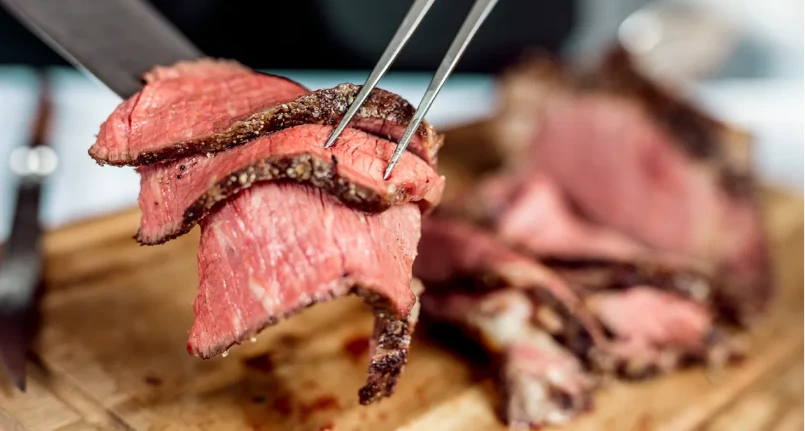Eat raw meat
Eating raw meat is an eating behavior that can sometimes be unhygienic or even risky.
There isn’t just one type of meat or cut for this raw meat: raw meat can be served in carpaccio , minced, “tartare” (finely chopped with a knife) or prepared in many other variations. Furthermore, contrary to what one might believe, the majority of the population feeds on it systematically; many types of sausages ( salami , dry sausage , soppressata , finocchiona, zia ferrarese etc.) – as well as salted meats ( raw ham ,speck , dried beef , dried cracklings , capocollo , loin, culatello , bresaola , etc.) – are NOT heat treated and undergo only certain conservation processes, including: salting, smoking , drying, spicing, dehydration by pressing, etc.
It is therefore possible to divide raw meat into two distinct categories: preserved raw meat and fresh raw meat . The preserved raw meat derives mainly from cattle (young and adult), pigs and horses for slaughter (little known salami anddried sausages of some poultry such as duck or goose). Fresh raw meat, on the other hand, is obtained above all from: young cattle (or at least veal ), slaughtered horse and duck.
It should be remembered that in order to appreciate good raw meat it is essential that it is soft and moderately lean; in order to obtain a similar result, the raw material must be made up of:
- Young animals
- Sedentary animals
- Skeletal muscles with little interest in the animal’s walking.
Choosing meat to eat raw
The reader will wonder: “… why must the muscle of origin of the raw meat belong to a young, sedentary animal and constitute a district not very involved in the fundamental movements of the animal ?”
Actually the answer is simple; skeletal muscles are made up of tissues that respond proportionally to the physical and hormonal stimuli induced by the animal’s lifestyle. In animals for slaughter or in game , they react exactly like those of the SPORTSMAN; making a trivial example: the athlete is characterized by a developed locomotor system and equipped with tonic , lean muscle tissue covered with capsules ofvery thick connective tissue . Conversely, a sedentary man should have a higher fat mass and less toned muscles with thinner and more delicate connective structures. For the same principle, the meat of a sedentary animal is always more tender than that belonging to a more active animal (just think of the morphological difference between the species; for example between a hare or a pheasant or a wild boar , which live in the wild , and a rabbit or a chicken or a farmyard pig ); the same goes for old ageof the animal and the anatomical district of origin. A very young specimen has muscles that are still underdeveloped because it moves less than an adult; at the same time, a less stressed muscle such as the ” fillet ” (internal muscle of the rear quarter) will always be more tender than another more recruited such as the “loin” (deputy for the extension of the rachis ).
Risks of eating raw meat
More than from a nutritional point of view, eating raw meat differs from a diet based on cooked foods especially for food HYGIENE .
It is probable that readers have already heard someone ADVISE a pregnant woman against eating sausages and salted or raw meats ; the reason is very simple: some animals, especially pigs and birds (chicken, hen , pigeon , etc.), are POTENTIAL carriers of pathogens such as parasites , bacteria and viruses .
It would be advisable to make an accurate classification of all the possibilities of contagion by differentiating bacterial contamination (generally induced by an infection but more often by bad slaughtering or cross-contamination), from viral contamination (less widespread but no less dangerous; the virus acts specifically on the cells , therefore many viruses harmful to one species could be harmless to others … but it is not a fixed rule) and finally from that attributable to parasites ( present directly in muscle tissue such as toxoplasma , tapeworm , the trichinella , the roundworm or thepinworms ; but also arrived in the butchered meat at a later time as for the amoeba and the giardia ). A separate discussion concerns prion contagion ; in short, prions are polypeptides (chains of amino acids ) which, for one reason or another, at a given moment and apparently without reason, CHANGE their structure by altering the function of the tissue they form; the most known and feared prions are those that give rise to the “Bovine Spongiform Encephalopathy” ( BSE ), also called ” mad cow ” disease”; these are constituents of the nervous tissue and their structural modification determines “spongy” lesions (holes and trabeculae) in the brain of the animal and, with very high probability, also in that of man. Except for the latter, in other cases mentioned above (except for meat widely contaminated by “gram-” bacteria ), cooking kills the pathogen, avoiding most of the risks of eating raw meat.
NB . Interested readers can learn more about the subject by consulting veterinary texts or more specific and detailed food hygiene issues; in addition, there are other similar problems related to the consumption of raw fish. The latter can be explored on the website in the article: ” Raw fish – risks and benefits of raw fish “.
Benefits of eating raw meat
To be honest, the benefits of eating raw meat aren’t many. These are mainly limited to:
- Preservation of greater hydration of the dish; in this way (as for all other fresh foods) the amount of water ingested increases, favoring the maintenance of the state of hydration (however, these are insignificant percentages)
- Conservation of electrolytes contained in muscle fibers ; with cooking, the mineral salts of the tissues tend to flow out with the cooking water, while by eating raw meat it is possible to improve the intake of iron (Fe), potassium (K), sodium (Na), magnesium (Mg – little ), chlorine (Cl) and calcium (Ca – little).
- Preservation of the molecular integrity of many vitamins . Some of these, being thermolabile , tend to become inactivated with cooking; we are talking about: Thiamine (vit. B1), Riboflavin ( vit. B2 ), Pantothenic acid ( vit. B5 ) and Retinol (or vit. A – little).
Even the digestibility of the food, if compared to that of medium-cooked meat (but with the necessary differences between the preparations), is sufficiently compromised. Heat facilitates protein denaturation at least as much as chewing (accentuated by grinding) and the acid reaction of hydrochloric acid and pepsin secreted in the stomach ; ultimately, properly cooked meat is more digestible than raw meat .




